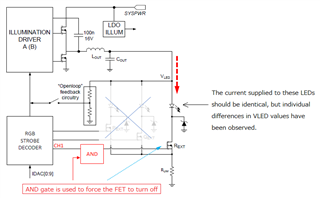Hi,
I have a question about the behavior of the INT_Z signal in the DLPA3005. I am facing a problem where the INT_Z signal is not working properly.
This signal should go Low when a fault condition is detected, but some devices do not so.
Our tests have revealed the following conditions:
1. VINA has 12.5V input.
2. INT_Z pin is externally pulled up.
3. For normally operating device, the output voltage (VLED) value exceeds 11V and INT_Z goes Low.
For devices operating abnormally, the output voltage (VLED) value does not exceed 11V and INT_Z does not go Low.
4. Both devices that operate normally and devices that operate abnormally show a gradual drop in voltage as if overvoltage protection has been applied.
5. When the current value supplied to the ILLUMINATION DRIVER is set to a large value, devices that were operating abnormally will also operate normally.
Why does INT_Z behave this way and what is the difference between normal and abnormal devices?
It is also possible to share INT_Z waveform data. I would appreciate it if you would allow me to private message you if necessary.
Best Regards,
UNA


